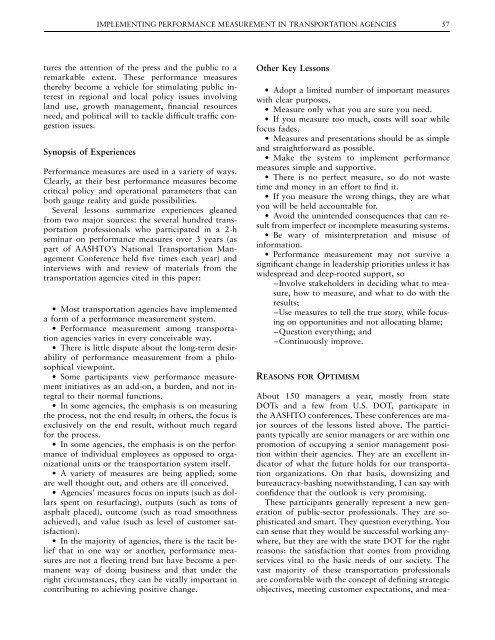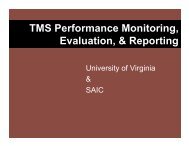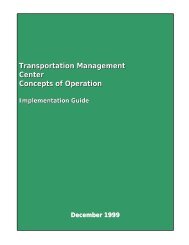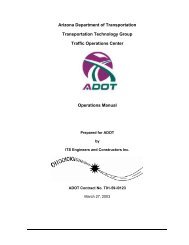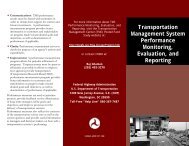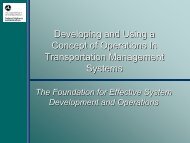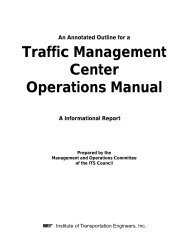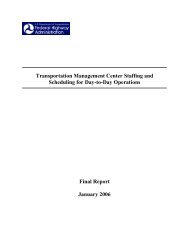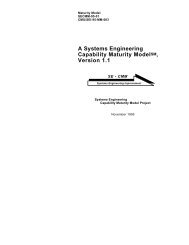Conference Proceedings 26 - Transportation Research Board
Conference Proceedings 26 - Transportation Research Board
Conference Proceedings 26 - Transportation Research Board
- No tags were found...
Create successful ePaper yourself
Turn your PDF publications into a flip-book with our unique Google optimized e-Paper software.
IMPLEMENTING PERFORMANCE MEASUREMENT IN TRANSPORTATION AGENCIES 57tures the attention of the press and the public to aremarkable extent. These performance measuresthereby become a vehicle for stimulating public interestin regional and local policy issues involvingland use, growth management, financial resourcesneed, and political will to tackle difficult traffic congestionissues.Synopsis of ExperiencesPerformance measures are used in a variety of ways.Clearly, at their best performance measures becomecritical policy and operational parameters that canboth gauge reality and guide possibilities.Several lessons summarize experiences gleanedfrom two major sources: the several hundred transportationprofessionals who participated in a 2-hseminar on performance measures over 3 years (aspart of AASHTO’s National <strong>Transportation</strong> Management<strong>Conference</strong> held five times each year) andinterviews with and review of materials from thetransportation agencies cited in this paper:• Most transportation agencies have implementeda form of a performance measurement system.• Performance measurement among transportationagencies varies in every conceivable way.• There is little dispute about the long-term desirabilityof performance measurement from a philosophicalviewpoint.• Some participants view performance measurementinitiatives as an add-on, a burden, and not integralto their normal functions.• In some agencies, the emphasis is on measuringthe process, not the end result; in others, the focus isexclusively on the end result, without much regardfor the process.• In some agencies, the emphasis is on the performanceof individual employees as opposed to organizationalunits or the transportation system itself.• A variety of measures are being applied; someare well thought out, and others are ill conceived.• Agencies’ measures focus on inputs (such as dollarsspent on resurfacing), outputs (such as tons ofasphalt placed), outcome (such as road smoothnessachieved), and value (such as level of customer satisfaction).• In the majority of agencies, there is the tacit beliefthat in one way or another, performance measuresare not a fleeting trend but have become a permanentway of doing business and that under theright circumstances, they can be vitally important incontributing to achieving positive change.Other Key Lessons• Adopt a limited number of important measureswith clear purposes.• Measure only what you are sure you need.• If you measure too much, costs will soar whilefocus fades.• Measures and presentations should be as simpleand straightforward as possible.• Make the system to implement performancemeasures simple and supportive.• There is no perfect measure, so do not wastetime and money in an effort to find it.• If you measure the wrong things, they are whatyou will be held accountable for.• Avoid the unintended consequences that can resultfrom imperfect or incomplete measuring systems.• Be wary of misinterpretation and misuse ofinformation.• Performance measurement may not survive asignificant change in leadership priorities unless it haswidespread and deep-rooted support, so–Involve stakeholders in deciding what to measure,how to measure, and what to do with theresults;–Use measures to tell the true story, while focusingon opportunities and not allocating blame;–Question everything; and–Continuously improve.REASONS FOR OPTIMISMAbout 150 managers a year, mostly from stateDOTs and a few from U.S. DOT, participate inthe AASHTO conferences. These conferences are majorsources of the lessons listed above. The participantstypically are senior managers or are within onepromotion of occupying a senior management positionwithin their agencies. They are an excellent indicatorof what the future holds for our transportationorganizations. On that basis, downsizing andbureaucracy-bashing notwithstanding, I can say withconfidence that the outlook is very promising.These participants generally represent a new generationof public-sector professionals. They are sophisticatedand smart. They question everything. Youcan sense that they would be successful working anywhere,but they are with the state DOT for the rightreasons: the satisfaction that comes from providingservices vital to the basic needs of our society. Thevast majority of these transportation professionalsare comfortable with the concept of defining strategicobjectives, meeting customer expectations, and mea-


